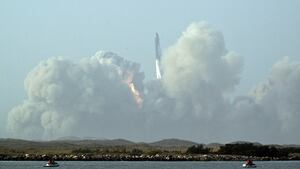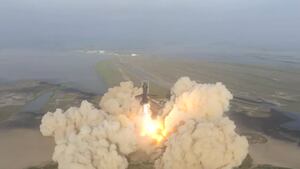This story has been updated with new information from the U.S. Fish and Wildlife Service.
The full version of SpaceX’s futuristic Starship launch vehicle took flight last week in the first-ever attempt to send it into space —making it off the launchpad in South Texas and climbing to 24 miles above the Earth’s surface before experiencing a “rapid unscheduled disassembly” (i.e. it exploded in a big ball of fire and debris).
While SpaceX is still conducting an investigation of what exactly went wrong, what we know so far is that Starship failed to separate from its first-stage rocket booster, the gargantuan and brand new Super Heavy. Both structures, stuck together, flipped several times over in the air before blowing up. SpaceX later released a statement saying it had triggered a self-destruct system put in place in case a problem like this occurred.
Despite the explosive ending, SpaceX and the aerospace community at large have hailed the launch as a success, providing valuable data about Super Heavy—along with a growing laundry list of what went wrong that includes several of Super Heavy’s engines malfunctioning, the stages not separating, and damage to the surrounding launch site.
“Congrats @SpaceX team on an exciting test launch of Starship!” SpaceX CEO Elon Musk tweeted after he was spotted looking considerably unhappy with the launch. “Learned a lot for next test launch in a few months.”
And SpaceX is no stranger to explosive outcomes. The company’s testing of Starship prototypes has often been promoted as unpredictable spectacles. Many of those ships have crashed and burned. And before that, SpaceX’s series of Falcon rockets were put through a gauntlet of flights that often ended badly as the company perfected its ability to land them safely.
But last week’s spectacle seems different. The damage that was caused by the launch was extensive. CNBC reported Monday that the Federal Aviation Administration has even grounded the Starship program as it investigates the impact it might have had on surrounding communities and ecosystems. (Neither the FAA nor SpaceX responded to requests for comment.)
Indeed, it marks a potential inflection point that might cause the company to rethink its decades-long brash approach. Starship is new, but SpaceX is not—and if it’s seeking to take more people into space and run missions at a vastly increased pace, it may not be able to afford to be so careless about playing damage control.
In the immediate aftermath of the mission, eagle-eyed viewers and experts noticed the considerable amount of damage done to to the launchpad, with huge chunks of the concrete missing to form a large crater beneath the launch site.
The damage seemed to have been caused by the lack of a flame diverter underneath the launchpad that would have redirected the intense engine fire and heat away from the rocket. Users dug up an October 2020 tweet from Musk in which he posted that SpaceX wouldn’t build a flame diverter on the launchpad, but acknowledged that “it could turn out to be a mistake.”
“I’ve seen pictures of a lot of damage at the launchpad and I suspect that’s more likely the result of the lack of flame diverter,” John Logsdon, a space policy expert at George Washington University and founder of the school’s Space Policy Institute, told The Daily Beast. He added that there was still a fair amount of “speculation” involved in any early assessments.
The launch also caused chunks of concrete to fly into and pummel nearby buildings and infrastructure, as well as a car parked nearby. The rocket threw up so much debris that clouds of dust blanketed the nearby town of Port Isabel, covering homes and cars with thick layers of grime. Sand- and ash-like matter spread out miles beyond the designated 700-acre debris field that was established before the launch. It’s unclear yet whether the matter could pose a health hazard. According to CNBC, residents of Port Isabel, a town nearby the Starship spaceport, some residents reported windows breaking in their homes and businesses.
Debris and particulate matter also flew into the ocean and into a nearby wildlife sanctuary—and even ended up starting a fire that spread for 3.5 acres, according to a statement sent to The Daily Beast from the U.S. Fish and Wildlife Service. Following an investigation, the service found “385 acres of debris on SpaceX's facility and at Boca Chica State Park” which is leased to the company by the government but managed as part of the Lower Rio Grande National Wildlife Refuge.
This is sure to dredge up tensions with SpaceX and environmental activists who have been fighting the launch site due to its potential harm to local ecosystems (including the beach habitat of the critically endangered Kemp’s Ridley sea turtle). Though no animals or birds were found harmed on park grounds, the less-than-favorable findings could result in even more scrutiny on the aerospace company, and further delays to future Starship test flights.
Chris Combs, an aerodynamics and mechanical engineering researcher at the University of Texas, San Antonio, pointed out that SpaceX already faced quite a bit of trouble with the FAA when the agency took years to finish its environmental review of the Starship and Super Heavy launch site and finally give its stamp of approval. The wait forced SpaceX to put a long pause on multiple projects.
“I think it’ll be really interesting to see what happens now, especially considering some of the aftermath like concrete going into the ocean, and shutting down the wildlife refuge,” Combs told The Daily Beast. “How much more is the government going to let them do from Boca?”
SpaceX’s startup-minded move-fast-and-break-things ethos is bold, and arguably helped the company perfect the landing system for its flagship Falcon 9 rocket. But Starship is a much bigger system. Breaking things means a much bigger cleanup.
Issues with the launchpad may have damaged several of Super Heavy’s engines. Logsdon noted that the engines are a completely different system from stage separation and are roughly “180 feet or 200 feet away from the burning engines at the tail end of the rocket,” so he is skeptical the two issues are related to each other. But he does allow the possibility that damage to the launchpad could have led to a kind of domino effect that eventually caused stage separation malfunction.
“One thing that’s really possible is that, because they have so many engines going out, the vehicle was tumbling and wasn’t totally in control,” Combs explained. “It’s possible that the separation orientation wasn’t really what it should have been when they tried to initiate it.”
What Combs means is that the vehicle essentially needed to be at a specific angle in order for separation to trigger. Since it wasn’t due to the engine failures, the weight of the rocket might have shifted and caused it to tumble. And this may have all stemmed from SpaceX’s decision to not include a flame diverter.
Musk acknowledged after the attempted orbital flight that SpaceX had begun preliminary construction of a “water-cooled, steel plate” to be placed under the launchpad. It “wasn’t ready in time,” but the company proceeded with the April 20 launch anyway.
That’s a pretty clear illustration of the culture that got SpaceX to where it is—and the culture that now may be holding it back. Much of SpaceX’s status as the world’s premiere innovator in space is a result of it trying and failing a lot, and learning as much as it could have along the way. That’s why the company almost seems to wear their failures like badges of pride. Each rocket explosion or booster crashing during landing attempts is a mark that they’re getting closer to their ultimate goals.
However, things are different now. SpaceX is no longer the startup it was when it was first attempting to land its Falcon 9 boosters. It’s grown to become the largest player in the aerospace industry, dominating and securing lucrative government and private contracts with ease. The move-fast-and-break-things ethos might now do them more harm than good. The installation of the flame diverter was already expected to delay further Starship flight tests for up to two months. And the FAA could keep Starship grounded for much longer while it continues to investigate what happened.
Nearby Boca Chica and the city of Brownsville are already feeling the full effects of having the world’s most successful rocket company right at their doorstep. This has drawn the ire of many residents who say that the frequent testing and explosions has led to immediate environmental effects like ocean pollution and scaring away native bird species. (Although not everybody’s upset: the towns are already experiencing an influx of revenue from tourists and SpaceX’s workers.)
“When you look around you see there’s dust, dirt, and sand on people’s houses. There's concrete in the ocean. I don’t know in what world that’s an insignificant impact,” Combs said. “Things like that are going to be reevaluated in a pretty severe way.”
For now, SpaceX and Musk are celebrating the launch as a victory—at least in public. In time, we’ll learn the full scope of what went into the failure and the full impact of the launch on wildlife and the surrounding communities.
But there’s no denying that the approach that got SpaceX to where it is today isn’t necessarily going to be the same approach that will get them to the moon and Mars. The decision to forgo a flame diverter might not only have ended up costing the company its booster and rocket, it also caused a host of physical and reputational damage, and could end up seeding new frustrations from the surrounding community. It shows that you can’t simply move fast and break things when you’re big—because the things you break also get bigger.








